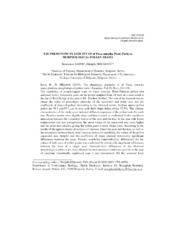Приказ основних података о документу
The phenotypic plasticity of of Picea omorika /Panc./Purkyne morphological pollen traits
| dc.creator | Batos, Branislava | |
| dc.creator | Miljković, Danijela | |
| dc.date.accessioned | 2019-06-19T13:43:12Z | |
| dc.date.available | 2019-06-19T13:43:12Z | |
| dc.date.issued | 2019 | |
| dc.identifier.uri | http://www.doiserbia.nb.rs/Article.aspx?ID=0534-00121901121B | |
| dc.identifier.uri | https://radar.ibiss.bg.ac.rs/handle/123456789/3370 | |
| dc.description.abstract | The variability of morphological traits of Picea omorika /Panč./Purkyne pollen was analyzed in two successive years on the pollen sampled from 24 trees in a seed stand at the site of Bela Zemlja in the area of Mt. Zlatibor (Serbia). The aim of the research was to obtain the index of phenotypic plasticity of the equatorial and polar axes and the coefficient of shape of pollen. According to the obtained results, Serbian spruce pollen grains are 93.3 μm/53.2 μm in size with their shape being oblate 57.5%. The climate characteristics of the study years initiated different responses of the pollen traits for each tree. Reaction norms were slightly steep and they crossed as confirmed by the significant interaction between the variability factors of the year and the tree. In the year with lower temperatures and less precipitation, the mean values of the equatorial axis were higher and the polar axis smaller, giving the pollen grain a more oblate form. According to the results of the applied model of analysis of variance where the year and the tree, as well as the interaction between them, were taken as factors of variability, the values of the pollen equatorial axis (length) and the coefficient of shape showed statistically significant differences between the years. Genetic variability (interindividual differences) for the values of both axes of pollen grains was confirmed by statistically significant differences between the trees in a single year. Interindividual differences in the observed morphological pollen traits were affected by environmental conditions specific to the year of sampling (statistically significant year x tree interaction). All the analyzed traits showed interindividual differences in the values of the plasticity index. The lowest values of plasticity were obtained for the equatorial axis (length) of the pollen grain, and they were significantly different from the plasticity indexes of the other traits analyzed herein. The plasticity of pollen traits has an important role in the controlled selection and breeding of species with the aim of obtaining more resistant genotypes with a greater ability to adapt to the fluctuations of environmental factors caused by global climate change. | en |
| dc.relation | info:eu-repo/grantAgreement/MESTD/MPN2006-2010/143007/RS// | |
| dc.rights | openAccess | |
| dc.rights.uri | https://creativecommons.org/licenses/by-nc-nd/4.0/ | |
| dc.source | Genetika | |
| dc.source | Genetika | |
| dc.subject | Picea omorika | |
| dc.subject | Pollen dimension | |
| dc.subject | Pollen shape | |
| dc.subject | Index of plasticity | |
| dc.title | The phenotypic plasticity of of Picea omorika /Panc./Purkyne morphological pollen traits | en |
| dc.type | article | en |
| dc.rights.license | BY-NC-ND | |
| dcterms.abstract | Миљковић, Данијела; Батос, Бранислава; | |
| dc.rights.holder | © 2019 Serbian Genetics Society | |
| dc.citation.issue | 1 | |
| dc.citation.volume | 51 | |
| dc.identifier.doi | 10.2298/GENSR1901121B | |
| dc.identifier.scopus | 2-s2.0-85066020227 | |
| dc.identifier.wos | 000467414400011 | |
| dc.citation.apa | Batos, B. & Miljković, D. (2019). The phenotypic plasticity of of Picea omorika /Panc./Purkyne morphological pollen traits. Genetika, 51(1), 121–136. | |
| dc.citation.vancouver | Batos B, Miljković D. The phenotypic plasticity of of Picea omorika /Panc./Purkyne morphological pollen traits. Genetika. 2019;51(1):121–36. | |
| dc.citation.spage | 121 | |
| dc.citation.epage | 136 | |
| dc.type.version | publishedVersion | |
| dc.identifier.fulltext | https://radar.ibiss.bg.ac.rs/bitstream/id/5067/bitstream_5067.pdf | |
| dc.citation.rank | M23 |

